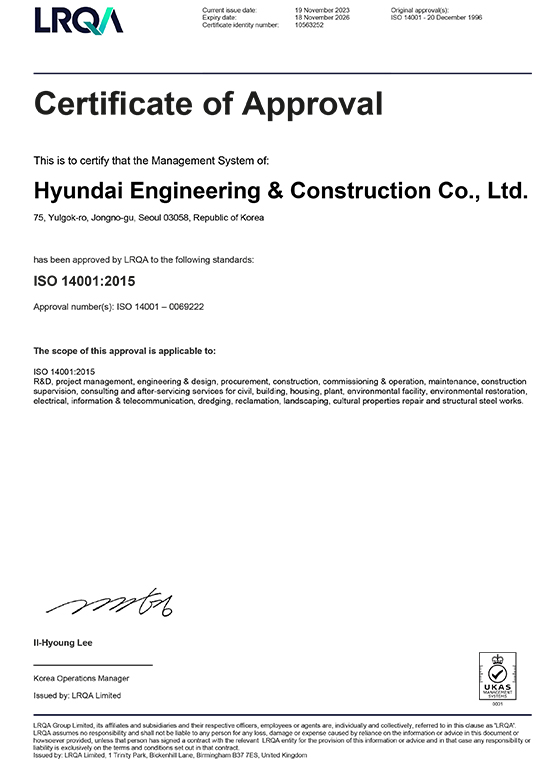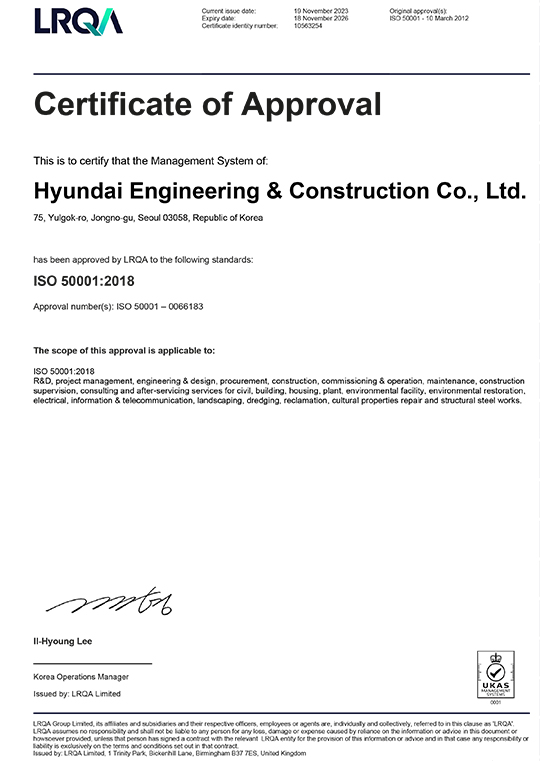Environment Management
We will create value as a global green enterprise through environment and energy management.
Hyundai E&C has promoted multi-faceted strategies and activities for its environment and energy management system to achieve the vision of “2030 Global Green One Pioneer.” We also obtained the international standard of the ISO 14001/50001 certification for our environment and energy management system by incorporating the green and energy-friendly management system throughout our business activities. Furthermore, we will take the lead in preserving the environment across the world through active carbon management activities in recognition of the importance of responding to climate change.
Hyundai E&C Environment and Energy Management System
Hyundai E&C minimizes environmental impact caused by construction projects by operating the systematic environment and energy management system.
Plan
- Establish environment energy management policy and objective
- Environmental Energy management plan
- Construction environment management plan
- Identify and manage environmental regulation
- Evaluate environmental risk & opportunity
- Energy baseline review
- Manage and plan important environmental aspects
Do
- Education and training on environment energy
- Environmental emergency preparedness and response
- Communication and discuss on environment energy
- Measure and analyze environment result
- Reduce GHG emissions and energy consumption
Check
- Report energy use result
- Inspect and Monitor environment and energy
- Evaluate compliance of obligations
- Corrective actions on nonconformity
Act
- Management review on environment and energy
Management Performance
-
Greenhouse gas (GHG) emissions
Background
For low carbon green growth, Hyundai E&C pre-emptively responds to climate change policies and domestic and international regulations and excavates new carbon business opportunities
Direction
Manage and reduce GHG emissions by calculating emissions quantitatively
GHG emissions
(unit: kilo tCO2-eq)
GHG emissions : Direct + Indirect + Other Indirect
Emission target/performance difference due to calculation method revision (2020)
GHG emissions intensity
(unit: tCO2-eq/100 Million KRW)
GHG emissions intensity : DomesticㆍOverseas direct + indirect / DomesticㆍOverseas Sales (Separate financial)
-
Energy consumption
Background
For low carbon green growth, Hyundai E&C pre-emptively responds to domestic and international climate change policies and regulations
Direction
Manage and reduce energy consumption by calculating energy consumption quantitatively
Energy Consumption
(unit:TJ)
Energy Consumption Intensity
(unit: TJ / 100 Million KRW)
Total energy consumption / Sales (Separate financial)
- Waste volume
Background
Reduce cost and increase competitiveness in construction project bidding by minimizing waste volume
Direction
Monitor the volume of waste generated in construction site and manage the monitoring performance
Waste volume
(unit: ton)
Net volume excluding recycled volume of the total waste volume
Classification by type of waste volume
(unit: ton)
2018~2023 type 2020 2021 2022 2023 Construction Wastes 856,470 762,594 1,184,155 1,263,722 recycling landfill incineration recycling landfill incineration recycling landfill incineration recycling landfill incineration 849,717 4,158 2,595 757,279 3,191 2,124 1,183,853 155 147 1,263,682 0 41 Industrial wastes 26,910 107,193 128,476 25,871 recycling landfill incineration recycling landfill incineration recycling landfill incineration recycling landfill incineration 26,726 0 183 106,965 39 189 124,527 3,845 104 25,681 153 36 Designated wastes 3 19 20 78 recycling landfill incineration recycling landfill incineration recycling landfill incineration recycling landfill incineration 0 2 1 4 0 15 16 0 4 73 5 0 Total waste volume 883,383 869,806 1,312,651 1,289,671 -
Water usage
Background
Reinforcement of environmental management through water usage management
Direction
Monitor and manage water usage in the business sites
Water usage
(unit: kilo-ton)
-
Environment management cost (investment and spending amount for environmental protection)
Background
Minimize damage to the environment and residents by conducting eco-friendly construction work
Direction
Include costs required in environment management for environmental damage and pollution prevention into construction cost
Performance
(Unit : 100 Million KRW)
* Environment management cost (investment cost and expense required in environmental protection) = Installation and operation cost for environmental pollution prevention facility + waste treatment and recycling cost
Certificates
-
- ISO 14001
- Environmental Management System
- Hyundai Engineering & Construction has established a system to minimize all environmental impacts involved in business activities and obtained ISO 14001 certification, the international standard for environmental management, through the LRQA in the UK in December 1996. We will continue to carry out environmental management activities based on the environmental management system.
· Acquisition Date : 20 Dec 1996 · Expiration Date : 18 Nov 2026
-
- ISO 50001
- Energy Management System
- In March 2012, Hyundai Engineering & Construction obtained the ISO 50001 certification, the international standard for energy management, for the first time among all global construction companies in order to reduce energy consumption through systematic energy management. We will continue to carry out the energy management system and do our best to reduce energy use.
· Acquisition Date : 10 Mar 2012 · Expiration Date : 18 Nov 2026
-
- Family-friendly certified company
-
- Dow Jones Sustainability Indices(DJSI)
- Construction·Engineering leader for 9 consecutive years
DJSI World for 15 consecutive years(2010-2025)
-
- Korea Institute of Corporate Governance and Sustainability(KCGS)
- Total rating A for 7 consecutive years(2018~2024)
Governance(B+), Social(A), Environmental(A)(2024)
-
- UN Global Compact(UNGC)
-
- Science Based Targets Initiative(SBTi)
-
- Carbon Disclosure Project
(CDP, Carbon Disclosure Project) - Hall of Fame for 7 consecutive years(2018~2024)
- 4 consecutive years (2021~2024) Platinum Club (highest ranking)
- Carbon Disclosure Project
-
- Red Dot · iF Award · IDEA Award
- Winning the ‘Grand Slam’ of the World's Top Three Design Awards
-
- Task Force on Climate-Related Financial Disclosures(TCFD)




